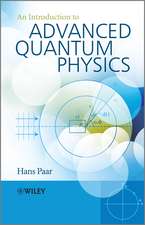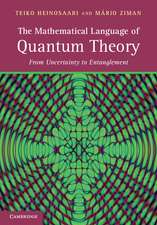Theoretical Physics: A Classical Approach
Autor Josef Honerkamp Traducere de H. Pollack Autor Hartmann Römeren Limba Engleză Paperback – 16 dec 2011
Preț: 654.62 lei
Preț vechi: 770.14 lei
-15% Nou
Puncte Express: 982
Preț estimativ în valută:
125.26€ • 131.11$ • 104.26£
125.26€ • 131.11$ • 104.26£
Carte tipărită la comandă
Livrare economică 31 martie-14 aprilie
Preluare comenzi: 021 569.72.76
Specificații
ISBN-13: 9783642779862
ISBN-10: 3642779867
Pagini: 588
Ilustrații: XIV, 569 p.
Dimensiuni: 155 x 235 x 31 mm
Greutate: 0.81 kg
Ediția:Softcover reprint of the original 1st ed. 1993
Editura: Springer Berlin, Heidelberg
Colecția Springer
Locul publicării:Berlin, Heidelberg, Germany
ISBN-10: 3642779867
Pagini: 588
Ilustrații: XIV, 569 p.
Dimensiuni: 155 x 235 x 31 mm
Greutate: 0.81 kg
Ediția:Softcover reprint of the original 1st ed. 1993
Editura: Springer Berlin, Heidelberg
Colecția Springer
Locul publicării:Berlin, Heidelberg, Germany
Public țintă
Professional/practitionerCuprins
1. Introduction.- 2. Newtonian Mechanics.- 2.1 Space and Time in Classical Mechanics.- 2.2 Newton’s Laws.- 2.3 A Few Important Force Laws.- 2.4 The Energy of a Particle in a Force Field.- 2.5 Several Interacting Particles.- 2.6 Momentum and Momentum Conservation.- 2.7 Angular Momentum.- 2.8 The Two-Body Problem.- 2.9 The Kepler Problem.- 2.10 Scattering.- 2.11 The Scattering Cross-Section.- 2.12 The Virial Theorem.- 2.13 Mechanical Similarity.- 2.14 Some General Observations About the Many-Body Problem.- Problems.- 3. Lagrangian Methods in Classical Mechanics.- 3.1 A Sketch of the Problem and Its Solution in the Case of a Pendulum.- 3.2 The Lagrangian Method of the First Type.- 3.3 The Lagrangian Method of the Second Type.- 3.4 The Conservation of Energy in Motions Which are Limited by Constraints.- 3.5 Non-holonomic Constraints.- 3.6 Invariants and Conservation Laws.- 3.7 The Hamiltonian.- 3.8 The Hamiltonian Principle of Stationary Action.- Problems.- 4. Rigid Bodies.- 4.1 The Kinematics of the Rigid Body.- 4.2 The Inertia Tensor and the Kinetic Energy of a Rigid Body.- 4.3 The Angular Momentum of a Rigid Body, Euler’s Equations.- 4.4 The Equations of Motion for the Eulerian Angles.- Problems.- 5. Motion in a Noninertial System of Reference.- 5.1 Fictitious Forces in Noninertial Systems.- 5.2 Foucault’s Pendulum.- 6. Linear Oscillations.- 6.1 Linear Approximations About a Point of Equilibrium.- 6.2 A Few General Remarks About Linear Differential Equations.- 6.3 Homogeneous Linear Systems with One Degree of Freedom and Constant Coefficients.- 6.4 Homogeneous Linear Systems with n Degrees of Freedom and Constant Coefficients.- 6.5 The Response of Linear Systems to External Forces.- Problems.- 7. Classical Statistical Mechanics.- 7.1 Thermodynamic Systems and Distribution Functions.- 7.2 Entropy.- 7.3 Temperature, Pressure, and Chemical Potential.- 7.4 The Gibbs Equation and the Forms of Energy Exchange.- 7.5 The Canonical Ensemble and the Free Energy.- 7.6 Thermodynamic Potentials.- 7.7 Material Constants.- 7.8 Changes of State.- 7.9 The Transformation of Heat into Work, the Carnot Efficiency.- 7.10 The Laws of Thermodynamics.- 7.11 The Phenomenological Basis of Thermodynamics.- 7.12 Equilibrium and Stability Conditions.- Problems.- 8. Applications of Thermodynamics.- 8.1 Phase Transformations and Phase Diagrams.- 8.2 The Latent Heat of Phase Transitions.- 8.3 Solutions.- 8.4 Henry’s Law, Osmosis.- 8.5 Phase Transitions in Solutions.- Problem.- 9. Elements of Fluid Mechanics.- 9.1 A Few Introductory Remarks About Fluid Mechanics.- 9.2 The General Balance Equation.- 9.3 Particular Balance Equations.- 9.4 Entropy Production, Generalized Forces, and Fluids.- 9.5 The Differential Equations of Fluid Mechanics.- 9.6 A Few Elementary Applications of the Navier-Stokes Equations.- Problem.- 10. The Most Important Linear Partial Differential Equations of Physics.- 10.1 General Considerations.- 10.2 Solutions of the Wave Equation.- 10.3 Boundary Value Problems.- 10.4 The Helmholtz Equation in Spherical Coordinates, Spherical Harmonics, and Bessel Functions.- Problems.- 11. Electrostatics.- 11.1 The Basic Equations of Electrostatics and Their First Consequences.- 11.2 Boundary Value Problems in Electrostatics, Green’s Functions.- 11.3 The Calculation of Green’s Functions, the Method of Images.- 11.4 The Calculation of Green’s Functions, Expansion in Spherical Harmonics.- 11.5 Localized Charge Distributions, the Multipole Expansion.- 11.6 Electrostatic Potential Energy.- Problems.- 12. Moving Charges, Magnetostatics.- 12.1 The Biot-Savart Law, the Fundamental Equations of Magnetostatics.- 12.2 Localized Current Distributions.- 13. Time Dependent Electromagnetic Fields.- 13.1 Maxwell’s Equations.- 13.2 Potentials and Gauge Transformations.- 13.3 Electromagnetic Waves in a Vacuum, the Polarization of Transverse Waves.- 13.4 Electromagnetic Waves, the Influence of Sources.- 13.5 The Energy of the Electromagnetic Field.- 13.6 The Momentum of the Electromagnetic Field.- 14. Elements of the Electrodynamics of Continuous Media.- 14.1 The Macroscopic Maxwell Equations.- 14.2 Electrostatic Fields in Continuous Media.- 14.3 Magnetostatic Fields in Continuous Media.- 14.4 Plane Waves in Matter, Wave Packets.- 14.5 Reflection and Refraction at Plane Boundary Surfaces.- Appendices.- A. The ?-Function.- B. Conic Sections.- C. Tensors.- D. Fourier Series and Fourier Integrals.- D.1 Fourier Series.- D.2 Fourier Integrals and Fourier Transforms.- E. Distributions and Green’s Functions.- E.1 Distributions.- E.2 Green’s Functions.- F. Vector Analysis and Curvilinear Coordinates.- F.1 Vector Fields and Scalar Fields.- F.2 Line, Surface, and Volume Integrals.- F.3 Stokes’s Theorem.- F.4 Gauss’s Theorem.- F.5 Applications of the Integral Theorems.- F.6 Curvilinear Coordinates.- Problems.- References.














